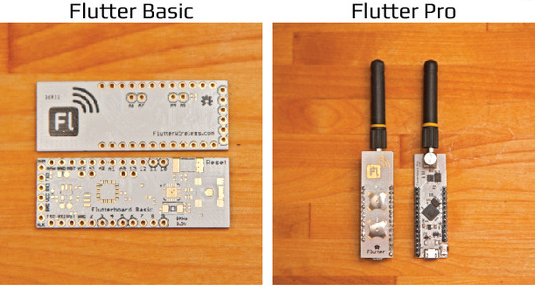Getting Arduino-powered devices to talk to each other over long distances is going to get cheaper and easier if this Kickstarter project flies. Flutter is a wireless development platform for Arduino with over half a mile of usage range — making it suitable for outdoor projects covering greater distances than Wi-Fi can comfortably manage.

Possible use-cases could include home automation systems, flying bots like quadcopters, environmental monitoring systems and radio-controlled cars. In short any Arduino-powered project that needs to ferry data from one relatively distant point to another. Flutter’s range will be 1,000m+ (3,200ft) but its creators also intend to include a mesh networking component, so multiple devices can be positioned to cover even greater distances than the standard half mile+ range.
The plan — assuming Flutter hits its crowdfunding target of $80,000 to turn its current Kickstarter prototypes into shipping product — is to offer two main Flutter board options to network up your devices: a basic board costing $20 and a pro board with a built in antenna for $30. The boards will be powered by an Atmel SAM3s ARM CPU.
The Flutter Basic board will have an integrated (rather than external) antenna and is smaller in size thanks to having components on both sides. It also has a micro USB for power and programming, an LED, and a button, plus digital and analog I/O. The Pro board will include battery charging, a professional screw mount antenna, an additional button, and more memory for more code.
Flutter’s makers also plan to offer a few other bits of kit to flesh out their wireless system, including a variety of shields for easier plug and play (and minimal soldering); a home base station which can connect to a router via Ethernet or Wi-Fi; and a Bluetooth shield for talking to a smartphone and interfacing with a planned Flutter mobile app.
Security is an obvious focus for Flutter’s creators — being as you’re transmitting potentially sensitive data over relatively large distances where it could be intercepted. Data transfers will be encrypted and the Flutter devices themselves will include a cryptographic chip to store and protect encryption keys.
The project is also open source. “Every aspect of our system will be made available, from schematics, board designs, the bill of materials, right down to the firmware and mobile app. We want to make it as easy as possible for you to build or improve upon our foundation,” they note. Plus they intend to offer a set of tutorials to open up wireless development to a broader base of makers.
